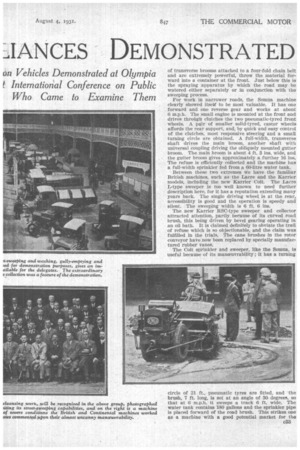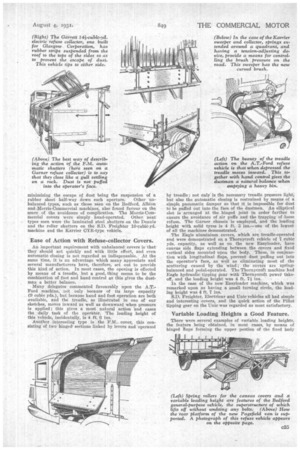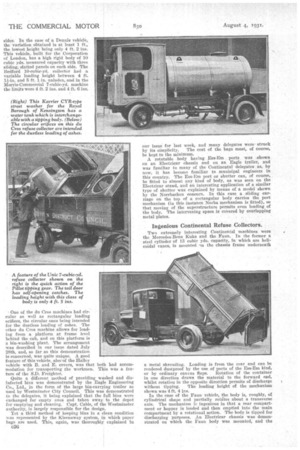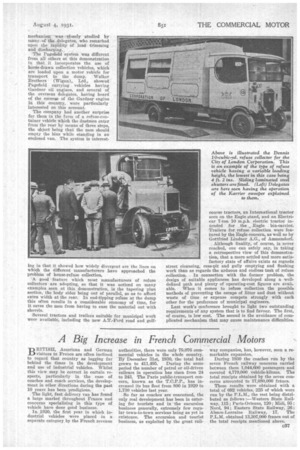PUBLIC CLEANSING APE JANCES DEMONSTRATED
Page 54

Page 55

Page 56

Page 57

Page 58

Page 59

If you've noticed an error in this article please click here to report it so we can fix it.
How the Appliances and Refuse-coth in Connection with Last Week's Cleansing Impressed the Delega on Vehicles Demonstrated at Olympia t International Conference on Public Who Came to Examine Them
FROM the point of view of those interested in mechanical appliances for street cleansing, refuse collection, gully emptying, etc., Wednesday was the most important day of the First International Conference on Public Cleansing which was held in London last week. The vehicles and appliances were available for inspection on the other days, but Wednesday afforded by far the best opportunity for examining them, and on that day demonstrations took place in the large hall at Olympia which enabled the delegates to watch closely the various appliances while they were doing their best to cope with work which, it cannot be denied, was unnaturally severe.
For the mechanical road sweepers, for instance, the concrete floor was spread with dust, paper and other litter, even inclusling bricks and pieces of wood, more copiously than would ever be found in practice, except perhaps in the streets of Eastern bazaars ; moreover, the litter was dry, so that it was impracticable to sweep or collect it without stirring up a good deal of dust. Perfectly dry litter of this kind would not, in the ordinary course, lie about in the streets, but would drift with the breezes and collect in corners. Mechanical sweepers naturally cannot work so effectively with such dry material, so that the test was a severe one.
Despite the fact that a fair quantity of dust was stirred up, the delegates did not hesitate to walk about where the machines were Working. This gave them an opportunity for seeing two or three sweepers at work at once, enabling them to compare their speeds, degrees of silence, sweeping widths and the effectiveness of their work.
"Useful details of all the exhibits, as well as a number of illustrations Of them, were included in our issue for last week, but we are now able to report upon the Impression made by the appliances while being examined by and demonstrated to the various delegates.
So far as sweepers were concerned, the two extremes were represented by the large Faun sweeper and the
small but extremely handy Somua appliance, both foreign machines. The Faun sweeper is a wide and big machine and is intended mainly for night work in big cities, for which it is obviously well suited. It has a, vertical rotating brush at the side for clearing out gutters, and the main brushes, which are in the form
of transverse brooms attached to a four-fold chain belt and are extremely powerful, throw the material forward into a container at the front. just below this is the spraying apparatus by which the road may be watered either separately or in conjunction with the sweeping process.
For work in narrower roads, the &cilia machine clearly showed itself to be most valuable. It has one forward and one reverse gear and works at about 6 m.p.h. The small engine is mounted at the front and drives through clutches the two pneumatic-tyred front wheels. A pair of smaller solid-tyred, castor wheels, affords the rear support, and, by quick and easy control of the clutches; most responsive steering and a small turning circle are obtained. A full-width, transverse shaft drives the main broom, another shaft with universal coupling driving the obliquely mounted gutter broom. The main broom is about 4 ft. 3 ins, wide, and the gutter broom gives approximately a further 16 ins. The refuse is efficiently collected and the machine has a full-width sprinkler fed from a 60-litre water tank.
Between these two extremes we have the familiar British machines, such as the Lacre and the Karrier models, including the new Karrier Colt. The Lacre L-type sweeper is too well known to need further description here, for it has a reputation extending many years back. The single driving wheel is at the rear, accessibility is good and the operation is speedy and silent. The sweeping width is 6 ft. 6 ins.
The new Karrier ESC-type sweeper and collector attracted attention, partly because of its curved road brush, this being driven by bevel gearing operating in an oil bath. It is claimed definitely to obviate the trail of refuse which is so objectionable, and the claim was fulfilled in the trials. The cane brushes in the rotor conveyor have now been replaced by specially manufactured rubber vanes.
The Colt sprinkler and sweeper, like the Somua, is useful because of its manoeuvrability ; it has a turning
mailer towns as well as for the narrow streets of big 'Wes.
The Guy sweeper and loader has the K-type, 2-21-ton !hassis. In this case the gutter brush throws the refuse awards, and the main brush, which is 5 ft. 2 ins, wide aid mounted behind the rear axle, sweeps the refuse into a ;cries of 21 buckets fitted with an elevator chain. A 21-gallon eater tank is fitted in the roof of the cab.
It was not convenient thoroughly to demonstrate the atrious street-washing machines, but these were closely • xamined by the delegates, who were particularly interested n those, such as the Dennis, that were suitable for gully raptying as well as for street-watering work. The 1,100;anon and 1,200-gallon machines were both there.
Interest Created by Convertible Machines.
The convertibility of machines rendering them suitable for ;utter flushing, sewer flushing, etc., as well as gully and ..esspool emptying, seemed particularly to attract visitors from overseas. The Dennis 550-gallon gully etriptier, flusher and general‘purpose machine, the Halley with Eagle equipment, the Karrier CYR-type washer, with interchangeable tipping body, and the S.D. Freighter chassis equipped with S00-gallon tank for street washing, all received a fair amount of attention. The tank of the last-mentioned machine has gravity-fed sprinklers and a gully-flushing jet. The tank of the Dennis is quickly replaceable by a tipping body.
Petrol-driven, as well as steam-driven, gully emptiers of small and large sizes were available, the former being represented by the Dennis, Albion, Karrier and Thornycroft makes, and the latter by the Fowler and the Yorkshire. The smallest Dennis machine, which has a capacity of 350 gallons, employs the popular 30-cwt., pneumatic-tyred chassis. Eagle equipment for this class of work was prominent, the Thornycroft 800-gallon type being a splendid exampTe.
A feature of the Fowler mechanism for this work is the patented vacuum tank which, by means of the steam ejector, raises a working vacuum in less than half a minute.
Refuse Collection the Biggest Problem ?
There is no doubt that the subject which demands the closest attention of all those under discussion at this Conference, particularly from the point of .view of the cost of operation, is that of the collection of refuse, the principal problem being that of domestic refuse, since this involves large numbers of calls for bins containing comparatively small quantities of material. Although during the past few years rapid strides have been made in minimizing this difficulty it is still plainly existent.
At the demonstration the simplest and the most complicated methods, as well as several intermediate systems, were presented to the delegates. For collection from small groups of houses, such as in rural areas, the matter is not one in which the municipal authorities find it difficult to make a
decision. It is obvious that they must use some kind of general-purpose vehicle with a fairly big capacity, one which can be employed for carrying road materials or for other work if necessary.
The Bedford 2-tonner, built on the short-wheelbase chassis, and having a capacity, by measurement, of about 6 cubic yds., provides an inexpensive and representative example. The superstructure, carrying four canvas covers on spring rollers, can be lifted off by means of overhead tackle and requires no bolts or other fastenings.
One of the Morris-Commercial 35-40-cwt. machines shown also was suitable for this kind of work. An advantage, in this case, as with the Bedford, is that a standard chassis is employed. Incidentally, the semi-circular sliding steel covers on the Morris-Commercial afford a fair measure of prevention of the scattering of refuse on a windy day.
There was a number of examples of hand and footoperated, balanced and unbalanced covers as applied to refuse-collection vehicles of low loading height In the case of the Garrett large-capacity machine, which will hold 14k cubic yds. of -material, vertical rubber strips were employed, and this idea found favour by reason of its simplicity. It might be said, in fact, that simplicity appealed to all of the delegates, most of them being men who knew the troubles of complicated maintenance tasks. The loading height of this Garrett machine is 4 ft. 6 ins. and it is designed for tipping, to either side. The B. and E. patented spring doors on the G.V. electric vehicle are quickly and easily worked, a good feature for minimizing the escape of dust being the suspension of a rubber sheet half-way down each •aperture. Other unbalanced types, such as those seen on the Bedford, Albion and Morris-Commercial machines, also found favour on the score of the avoidance of complication. The Morris-Commercial covers were simply hand-operated. Other neat types seen were the laminated steel .shutters.on the Dennis and the roller shutters on the S.D. Freighter 10-cubic-yd. machine and the Karrier CYR-type vehicle.
Ease of Action with Refuse-collector Covers.
An important requirement with unbalanced.covers isthat they should act quickly and with little effort, and even automatic closing is not regarded as indispensable. At the same time, it is an advantage which many appreciate and several manufacturers have, therefore, set out to provide this kind of action. In most cases, the opening is effected by means of a treadle, but a good, thing seems to be the combination of foot and hand control as this gives the dustman a better balance.
Many delegates commented favourably upon the A.T.Ford machine, not only because of its large capacity (.:} cubic yds.), but because hand and foot operation are both available, and the treadle, as illustrated in one of our sketches, moves inward as well as downward when pressure is applied ; this gives a most natural action and eases the daily task of the operator. The loading height of this vehicle, incidentally, is 4 ft. 6 ins.
Another interesting type is the F.M., cover, this consiating of two hingedsections linked by levers and operated by treadle not only is the necessary treadle pressure light, but also the automatic closing is restrained by means of a simple pneumatic damper so that it is impossible for dust to be puffed out into the face of the 'dustmen. An elliptical slot is arranged at the hinged joint in order further to ensure the avoidance of air puffs and the trapping of loose refuse. The Garner chassis is employed, and the loading height with solid tyres is 4 ft. 2 ins.—one of the lowest of all the machines demonstrated.
The Eagle aluminium covers, which are treadle-operated and were demonstrated on a Thornycroft vehicle of 7 Cubic yds. capacity, as well as on the new Easyloader, have canvas side naps extending between the covers and fixed vertical sides mounted upon the body. These, in conjunction with longitudinal flaps, prevent dust pulling out into the operator's face, as well as eliminating most of the scattering caused by the wind ;• the covers are springbalanced and pedal-operated. The Thornycroft machine had Eagle hydraulic tipping gear with Thornycroft power take
off, and the loading height was 4 ft. 71 ins.
In the ease of the new Easyloader machine, which was remarked upon as having a small turning circle, the loading height was 4 ft. 7 ins. • S.D. Freighter, Electricar and Unic vehicles all had simple and interesting covers, and the quick action of the Pillot tipping gear on the Unite was regarded as most satisfactory.
Variable Loading Heights a Good Feature.
There were several examples of variable loading heights, the feature being obtained, in most cases, by means of hinged flaps forming the upper portion of the fixed body sides. In the case of a Dennis vehicle,. the -variation obtained is at least 1 ft., the loWest height being only 4 ft. 2 ins. This vehicle, built for the Corporation of London, has a high rigid body of 10 cubic yds. measured capacity with three sliding slatted panels on each side. The Bedford 10-cubie-yd. collector had a variable loading height between 4 ft. 11-in. and 5 ft. 1 in. unladen, and in the Morris-Commercial 7-cubic-yd. machine the limits were 4 ft. 2 ins. and 4 ft. 6 ins.
One of the du Oros machines had circular as well as rectangular loading orifices, the circular ones being intended for the dustless loading of ashes. The other du Cros machine allows for loading from a platform at frame level behind the cab, and on this platform is a bin-washing plant. The arrangement was described in our issue dated July 28th, and, so far as this demonstration is concerned, was quite unique. A good feature of this vehicle, also of the Halley vehicle with B. and E. covers, was that both had accommodation for transporting the workmen. This was a feature of the S.D. Freighter.
Quite a different method of providing washed and disinfected bins was demonstrated by the Eagle Engineering Co., Ltd., in the form of the large bin-carrying trailer as used by Westminster City Council. This was demonstrated to the delegates, it being explained that the full bins were exchanged for empty ones and taken away to the depot for emptying and cleaning. Capt. Cable, of the Westminster authority, is largely responsible for the design.
Yet a third method of keeping bins in a clean condition was represented by the Kleenaway system, in which paper bags are used. This, again, was thoroughly explained lu
t36
our issue for last week, and many delegates were • struck by its simplicity. The cost of the bags must, of course, be kept to the minimum.
A rotatable body having Ess-Em ports was -shown on an Electricar chassis and on an Eagle trailer, and was familiar to many of the Continental delegates as, by now, it has become familiar to municipal engineers this country. The Ess-Em port or shutter can, of course, be fitted to almost any kind of body, as was seen on the Electricar stand, and an interesting application of a similar type of shutter was explained by means of a model shown by the Norrbacken concern. In this case a sliding carriage on the top of a rectangular body carries the port mechanism (in this instance Norba mechanism is fitted), so that moving of the superstructure permits even loading of the body. The intervening space is covered by overlapping metal plates.
. Ingenious Continental Refuse Collectors.
Two extremely interesting Continental machines were the Mercedes-Benz Kuka and the Faun. In the former a steel cylinder a 13 cubic yds. capacity, in which are hellcoidal vanes, is mounted an the chassis frame underneath
a metal shrouding. Loading is from the rear and can he rendered dustproof by the use of ports of the Ess-Em kind, or by ordinary canvas flaps. Rotation of the container in one direction draws the material to the forward end, whilst rotation in the opposite direction permits of discharge without tipping. The loading height of the mechanism shown was 4 ft. 4 ins.
In the case of the Faun vehicle, the body is, roughly, of cylindrical shape and partially rotates about a transverse axis. 'The mechanism is ingenious in that a rear compartment or hopper is loaded and then emptied into the main compartment by a rotational action. The body is tipped for discharging purposes. An Electricar chassis was demonstrated on which the Faun body was mounted, and the mechanism:" wa.s ..,-closely studied by many, of the .delegates, who remarked upon the rapidity of load trimming and discharging.
The Pagofield system was different from all others at this demonstration in that it incorporates the use of horse-drawn collection vehicles, which are loaded upon a motor vehicle for transport to the dump. Walker Brothers (Wigan), Ltd., showed Pagefield carrying vehicles having Gardner oil engines, and several of the overseas delegated, having heard of the success of the Gardner engine in this country, were particularly interested on this account.
The company had another surprise for them in the form of a refuse-container vehicle which the dustmen enter from the rear by means of three steps, the object being that the men should empty the bins while standing in an enclosed van. The system is interest
jag in that it showed how widely divergent are the lines on -which the different manufacturers have approached the problem of house-refuse collection.
good feature which most manufacturers of refuse collectors are adopting, so that it was noticed on many examples seen at this demonstration, is the tapering plan section, the body sides being out of parallel, so as to afford extra width at the rear. In end-tipping refuse at the dump this often results in a considerable economy of time, for it saves the men from having to ease the material out with shovels.
Several tractors and trailers suitable for municipal work were available, including the new A.T.-Ford road and golf course tractors, an International tractor seen on the Eagle stand, and an Electricar 7-tan 10 m.p.h. electric tractor intended for the Eagle bin-carrier. Trailers for refuse collection were featured by the Eagle concern, as well as by Gottfried Lindner A.G., of Ammendorf. , Although finality, of course, is never reached, one can safely say, in taking a retrospective view of this demonstration, that a more settled and more satisfactory state of affairs exists as regards street cleansing, cess-pit and gully emptying and flushing work than as regards the arduous and endless task of refuse collection. In connection with the former problem, the design of suitable appliances has developed along a welldefined path and plenty of operating-cost figures are avail,. able. When it comes to refuse collection the possible methods of preventing the escape of litter and dust 'without waste of time or expense compete strongly with each other for the preference of municipal engineers.
Last week's conference brought to light two outstanding requirements of any system that is to End favour. The first, of course, is low cost. The second is the avoidance of complicated mechanism that may cause maintenance difficulties.












































































































